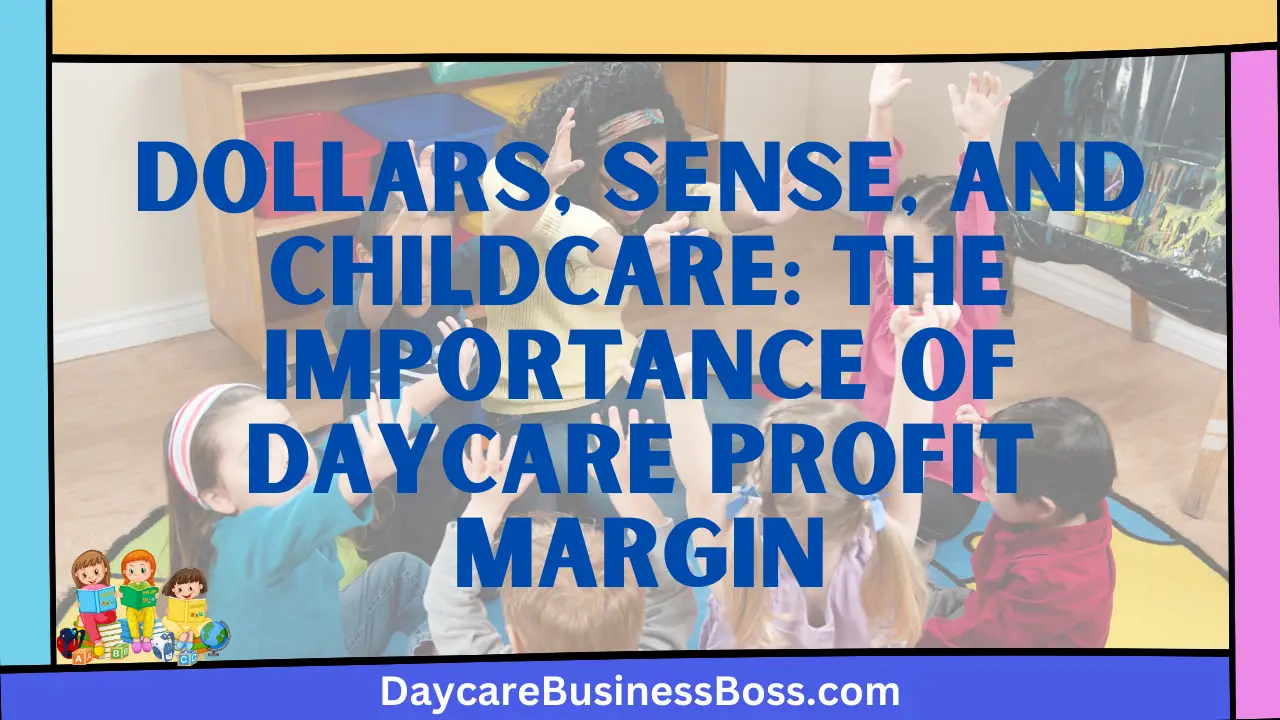Running a daycare business is a multidimensional job that entails not only providing great care to children but also balancing the intricate balance of expenses and earnings. The daycare profit margin is at the center of this financial equation, and it is a vital parameter that defines the profitability, sustainability, and sustainability of such operations.
To best secure profitability in daycare businesses, you should aim for a profit margin between 15% to 35%. This figure is shaped by factors such as location, enrollment, and operational efficiency.
This article delves into the topic of daycare profit margins, revealing their significance, the factors that determine them, and ways for achieving optimal profitability. Join us as we navigate the worlds of financial complexities and childcare excellence, exposing how mastering the daycare profit margin is the key to unlocking a wealthy future in the daycare company sector.
Understanding the Profit Margin Range

The profit margin, a fundamental financial statistic, denotes the fraction of total revenue that converts into actual profit after deducting all incurred expenses. The profit margin is especially important in the context of daycare enterprises since it acts as a key measure of financial health and operational effectiveness. In general, a profit margin of 15% to 35% emerges as the best zone, providing a harmonious balance between growth potential and pragmatic realization of the varied expenditures and intricacies inherent in the childcare sector.
This specified profit margin range demonstrates a sophisticated approach to financial management in the daycare industry. The lower limit is a profit margin of 15%, which ensures that adequate resources are provided to maintain care quality, recruit and retain skilled workers, and adhere to the severe regulatory criteria governing childcare services. Simultaneously, the upper limit of 35% allows for the fulfillment of expansion goals by encouraging investment in new facilities, instructional resources, and innovative programs.
Balancing within this profit margin spectrum is critical to the long-term productivity of daycare businesses. Compliance with safety requirements, personnel issues, and seasonal variations in demand are all particular challenges in the childcare sector. As a result, the 15% to 35% range reflects the reality of this industry, allowing for judicious revenue allocation to critical operational areas.
Read more about: Behind the Balance Sheet: Inside Adult Day Care Center Profit Margins
Location Matters
The geographical location of a childcare business is a major predictor of its profit margin, with a significant impact on income streams and, by extension, its profitability. The placing of a childcare center inside a given geographic area has a significant impact on its financial trajectory, as the interaction between location and demand fundamentally affects the business’s ability to generate revenue.
Urban settings, with their dense populations and lively activities, provide an ideal ground for daycare centers looking to increase their profit margins. The inherent advantage of metropolitan environments is the increased demand for childcare services, which is driven by an ever-expanding workforce and the need for working parents to get dependable care for their children. The rising demand, in turn, makes it easier to construct a price structure that can sustain a bigger profit margin, enhancing the center’s financial viability.
The appeal of easy accessibility enhances the daycare industry’s symbiotic relationship between location and profitability. Parents who are juggling career obligations and domestic responsibilities prioritize daycare centers that are conveniently located. The proximity of the daycare center to the parents’ workplaces or home locations has a big impact on their decision because it immediately impacts their daily routines and practical issues. As a result, a childcare center strategically located in an accessible location gains a competitive advantage, attracting a bigger pool of potential clients and improving the center’s ability to maintain an appropriate profit margin.
Enrollment: Balancing Capacity and Demand
Enrollment figures emerge as a critical gear in the sophisticated machinery that directs a daycare business’s profit margin. The delicate balance between the center’s capacity and the current demand for childcare services has a direct and significant impact on the establishment’s financial health and general viability. Striking this balance is a major challenge for daycare providers because it not only defines income potential but also affects profit margins dynamically.
Running a daycare facility at full capacity is consistent to optimize revenue creation, which increases the chances of obtaining a healthy profit margin. A busy center, where every available slot is filled, ensures optimal resource use and capitalizes on the entire spectrum of services provided. This increased enrolment translates into more steady cash flows, allowing the company to cover operational costs while creating the potential for a significant profit.
However, it is critical to navigate this search for maximal capacity while keeping a close eye on the quality of care offered. Overstretching the center’s capacity to increase enrollment numbers may jeopardize the degree of personalized attention and tailored care that parents demand for their children. This trade-off between number and quality highlights the complexities of daycare enrollment management.
A decrease in enrolment, on the other hand, might present its own set of issues, as unused resources lead to lower profitability. When there are too few enrolled children, certain expenses may become inefficient, causing financial strain. When fixed costs like staffing, infrastructure maintenance, and other overheads are not dispersed across an ideal number of enrolled children, they might become burdensome.
Operational Efficiency: Doing More with Less

The daycare industry’s operational efficiency, a pillar of profitability, covers a broad range of factors that merge to form the financial growth and sustainability of these organizations. It is a delicate balance of quality care, sensible resource allocation, and prudent cost management. When examining the intricacies of staffing, resource use, and administrative processes, this orchestration of operational excellence becomes especially apparent.
The delicate art of staffing is at the heart of operational efficiency. Finding the ideal staff-to-child ratio is critical for providing high-quality care while also remaining financially sustainable. A well-calibrated ratio ensures that each child receives the care and supervision they require while avoiding over-staffing. This balance between care standards and labor costs increases overall efficiency and, as a result, profit margins.
Another critical area where operational efficiency flourishes is resource use. Careful management of play equipment, supplies, and facility space results in less waste and more utility. Insightful resource management not only cuts unnecessary costs but also adds to a leaner operation that supports profitability. Efficient resource utilization also results in a better experience for children and parents, which strengthens the center’s reputation and hence the opportunity for increased enrolment.
Administrative operations, which are frequently the backbone of any firm, are no exception in the daycare industry. The implementation of cost-effective administrative methods and the integration of technology can greatly improve operational efficiency. Using digital tools to streamline scheduling, communication, and record-keeping systems, tasks that might otherwise occupy precious time and resources are accelerated. This not only cuts administrative costs but also improves communication between staff and parents, enhancing the overall experience and potentially attracting new customers.
Read more about: Childcare Business Navigator: Essential Management Coursework
Factors Affecting Profit Margin Distribution Within the Range
While a profit margin range of 15% to 35% is a useful benchmark for daycare enterprises, the complex interplay of multiple contributing factors ultimately defines the precise positioning within this spectrum. Economic conditions appear as a formidable factor, having a clear impact on parental choices and, as a result, daycare establishment profit margins. During economic downturns, families may gravitate toward more cost-effective childcare options, putting pressure on profit margins as centers adjust prices to remain competitive. In contrast, during periods of economic stability, parents desire to invest in quality childcare can create a climate conducive to higher profit margins flourishing.
Another important factor impacting profit margins is the regulatory environment. Daycare facilities operate within a framework of severe standards aimed to safeguard children’s safety and well-being. The expenses of complying with these laws can be significant, especially for smaller centers with limited financial resources. Noncompliance can result in serious penalties, such as fines or even closure, emphasizing the need of spending resources toward regulatory adherence, which can have an impact on the bottom line.
The strategic provision of distinct services is critical in defining profit margins. Daycare centers providing value-added offerings, such as specialized early childhood education programs or stimulating extracurricular activities, frequently can charge higher prices. This distinction not only increases the center’s appeal but also supports a higher pricing structure, potentially pushing the profit margin into the upper echelons of the established range.
Strategies for Achieving and Sustaining Optimal Profitability
Daycare organizations can strategically apply a variety of ways that line smoothly with the previously described elements to achieve profitability within the specified profit margin range of 15% to 35%. Creating a financial trajectory within this volatile spectrum necessitates a combination of intelligent decision-making, market response, and operational dexterity.
Conducting thorough market research is the foundation for reaching profitability. Identifying disadvantaged areas for daycare services and understanding demand trends might aid in the selection of an ideal site. This educated decision can have a substantial impact on enrollment numbers because closeness to parents’ businesses or residential regions increases the center’s appeal. Launching marketing efforts that highlight the center’s distinctive characteristics and convenience can significantly increase enrollments, having a beneficial ripple impact on revenue.
A planned and adaptable approach is required to achieve the delicate balance between enrollment capacity and demand. Continuous monitoring of enrollment trends, as well as the maintenance of waitlists, guarantees that the center operates at maximum capacity. This preventative technique avoids the hazards of either overextending resources, which may jeopardize quality, or underutilizing prospective revenue streams. In this pursuit, careful planning and reactivity to enrollment trends remain critical.
The key to long-term profitability is operational efficiency. Examining workforce ratios regularly, fine-tuning timetables, and leveraging technology to optimize everyday operations all contribute to a leaner and more cost-effective business model. The use of digital technologies for administrative activities, communication, and scheduling can greatly save manual labor and time, increasing efficiency and lowering operating costs. Negotiating beneficial arrangements with suppliers for necessities such as food, supplies, and cleaning services adds to cost reduction and, as a result, increases profit margins.
Frequently Asked Questions

What does the 15% to 35% profit margin range mean for daycare businesses?
The profit margin range of 15% to 35% is quite important in the daycare business since it represents a balanced approach to profitability. This range enables organizations to achieve long-term productivity while taking into account the particular problems and expenses of providing childcare services. Finding this happy medium enables daycare centers can meet their expenses, provide great care, and perhaps reinvest in their operations.
How does a daycare business’s location affect its profit margin?
The profit margin of a daycare business is heavily influenced by its location. Centers located in heavily populated locations or adjacent to workplaces and residential communities have increased demand and accessibility, potentially resulting in a higher profit margin. Centers in less populated or less accessible places, on the other hand, may have decreased demand, impacting their profitability. Choosing a strategic location that corresponds to the target population can have a major impact on revenue possibilities.
What measures may daycare firms use to maximize profits within the acceptable range?
Daycare organizations can employ a variety of tactics to attain and maintain profitability in the 15% to 35% range. Conducting extensive market research to determine demand trends and underserved areas aids in the selection of a favorable location. The use of waitlists and regular monitoring to balance enrollment capacity with demand prevents resource underutilization or overstretching. Focusing on operational efficiencies, such as staff-to-child ratios, technology integration, and cost-effective resource use, adds to a leaner and more gainful organization.
To learn more on how to start your own daycare checkout my startup documents here.
The information provided by DaycareBusinessBoss.com (“The Site”) is for general informational purposes only. All information on the Site is provided in good faith, however, we make no representation or warranty of any kind, express or implied, regarding the accuracy, adequacy, validity, reliability, availability or completeness of any information on the Site. Under no circumstance shall we have any liability to you for any loss or damage of any kind incurred as a result of the use of the Site or Reliance on any information provided on the Site. Your use of the Site and your reliance on any information on the Site is solely at your own risk.
This blog post is for educational purposes only and does not constitute legal advice. Please consult a legal expert to address your specific needs. Terms and Conditions. (https://daycarebusinessboss.com/terms-conditions/)

Meet Shawn Chun: Entrepreneur and Childcare Business Fan.
I’m a happy individual who happens to be an entrepreneur. I have owned several types of businesses in my life from a coffee shop to an import and export business to an online review business plus a few more and now I create online daycare business resources for those interested in starting new ventures. It’s demanding work but I love it. I do it for those passionate about their business and their goals. That’s why when I meet a childcare business owner, I see myself. I know how hard the struggle is to retain clients, find good employees and keep the business growing all while trying to stay competitive.
That’s why I created Daycare Business Boss: I want to help childcare business owners like you build a thriving business that brings you endless joy and supports your ideal lifestyle.


